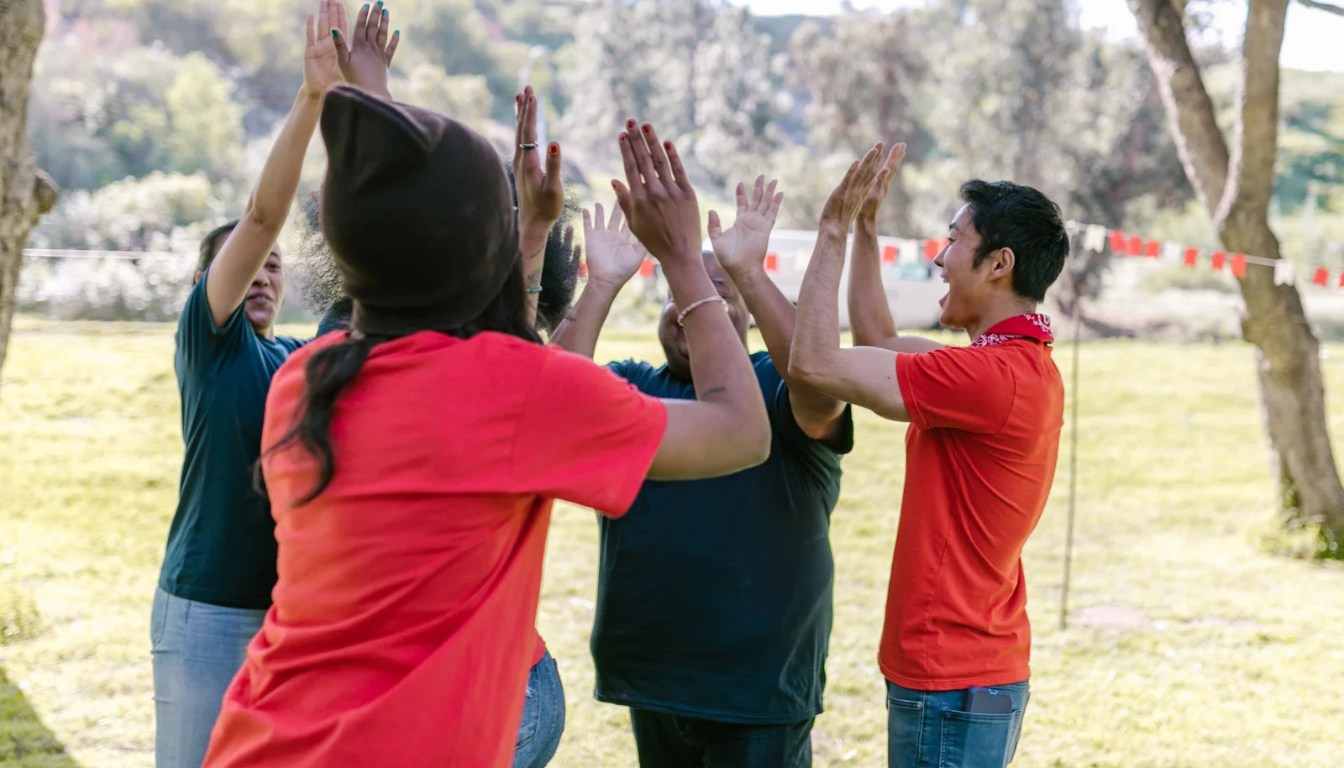Engaging Team Building Activities for Startups: Strategies for Stronger Teams

Team-building activities are an essential element for the success of any startup retreat. Not only do they foster strong bonds and enhance communication skills among team members, but they also promote collaboration, enhance problem-solving skills, and boost morale. In this comprehensive overview, we will delve into the importance of team-building activities for startups, identify the right activities for your team, explore innovative ideas for team-building, and provide tips on planning and executing successful team-building retreats. We will also discuss how to evaluate the impact of team-building activities and continuously improve your team-building strategies.
Understanding the Importance of Team-Building Activities

Team-building activities play a crucial role in the development and growth of startups. These activities are designed to engage the entire team, ensuring that every member participates and contributes to the overall success. They go beyond simple ice-breakers or recreational games; they are strategic tools that aid in building strong and cohesive teams. When individuals come together as a team and form connections beyond their professional roles, they are more likely to collaborate effectively, communicate openly, and support one another in achieving common goals.
Definition and Purpose of Team Building Activities
Team building activities are structured exercises designed to improve teamwork, communication, and problem-solving skills among team members. These activities aim to bring team members together, fostering collaboration and creating a positive work environment. The primary purpose of team building activities is to enhance team dynamics, build trust, and promote effective communication among team members. By participating in these activities, team members can develop a deeper understanding of each other’s strengths and weaknesses, leading to more cohesive and efficient teamwork.
The Role of Team-Building in Startups
In startups, where teams often work in close proximity and face unique challenges, team-building activities act as a catalyst for fostering a positive work culture. They are particularly effective in helping new team members integrate into the team, fostering a sense of belonging and understanding of team dynamics. By encouraging teamwork, startups can improve productivity, employee satisfaction, and retention rates. Engaging team-building activities provide opportunities for employees to step out of their usual work roles and build trust, empathy, and understanding among team members.
Benefits of Engaging Fun Team Building Activities

Engaging team-building activities have numerous benefits for startups. They promote effective communication, boost creativity, and foster problem-solving skills. These activities also help in strengthening team bonds, which are crucial for building trust and collaboration. By participating in such activities, team members learn to trust each other’s strengths and leverage their collective intelligence to overcome obstacles. Moreover, team-building activities can help break down hierarchical barriers, empowering every team member to contribute their ideas and opinions.
One key takeaway from this section is that team-building activities are not mere recreational events but powerful tools that can positively impact a startup’s overall performance and team dynamics.
Furthermore, team-building activities can also enhance employee morale and job satisfaction. When employees feel a sense of camaraderie and connection with their colleagues, they are more likely to feel motivated and engaged in their work. This can lead to increased job satisfaction and a higher level of commitment to the organization.
Additionally, team-building activities can help identify and develop leadership skills within the team. Through collaborative challenges and problem-solving activities, individuals have the opportunity to showcase their leadership abilities and take on roles that they may not have in their day-to-day work. This not only helps in identifying potential leaders but also empowers team members to step up and take initiative.
Identifying the Right Team-Building Activities for Your Startup
Choosing the right team-building activities for your startup requires careful consideration of various factors. Organizing regular team building events can significantly enhance team cohesion and morale. It’s important to select activities that align with your team’s goals, interests, and dynamics. Here are some factors to consider when making your choice:
Types of Team Building Activities

Team building activities can be categorized into various types, each serving a unique purpose in promoting teamwork and collaboration. Here are some of the most effective types of team building activities:
Fun Team Building Activities
Fun team building activities are designed to be enjoyable and engaging, while also promoting teamwork and collaboration. These activities provide a relaxed environment where team members can bond and have fun together. Examples of fun team building activities include:
- Scavenger Hunts: Teams work together to find items or complete tasks based on a list of clues.
- Escape Rooms: Team members must collaborate to solve puzzles and escape from a locked room within a set time.
- Team Sports: Activities like soccer, volleyball, or basketball encourage teamwork and physical activity.
- Game Nights: Board games or video games that require strategic thinking and cooperation.
- Cooking Classes: Teams work together to prepare a meal, fostering creativity and collaboration.
These activities are designed to be low-key and relaxed, allowing team members to bond and have fun while working together.
Funny Team Building Activities
Funny team building activities are designed to be humorous and entertaining, while also promoting teamwork and collaboration. These activities create a light-hearted atmosphere where team members can laugh and enjoy themselves. Examples of funny team building activities include:
- Comedy Improv: Team members participate in improvisational comedy exercises, encouraging creativity and quick thinking.
- Karaoke Nights: Singing together can break down barriers and create a fun, relaxed environment.
- Team Trivia: Teams compete to answer trivia questions, promoting knowledge sharing and teamwork.
- Prank Wars: Light-hearted pranks that are safe and fun can build camaraderie and trust.
- Funny Challenges: Activities like “Minute to Win It” games that are silly and entertaining.
These activities are designed to be light-hearted and entertaining, allowing team members to laugh and have fun while working together.
Quick Team Building Activities
Quick team building activities are designed to be short and efficient, while also promoting teamwork and collaboration. These activities are perfect for teams with limited time but still want to engage in team-building exercises. Examples of quick team building activities include:
- Icebreaker Games: Simple games that help team members get to know each other better.
- Team-Building Exercises: Short exercises that focus on specific skills like communication or problem-solving.
- Group Challenges: Quick challenges that require teamwork to complete, such as building a tower with limited materials.
- Brainstorming Sessions: Short sessions where team members generate ideas together.
- Creative Projects: Quick projects that require collaboration and creativity, such as designing a logo or creating a short video.
These activities are designed to be fast-paced and engaging, allowing team members to quickly bond and work together effectively.
By incorporating a variety of team building activities, startups can create a dynamic and engaging environment that fosters collaboration, communication, and problem-solving skills among team members.
Factors to Consider When Choosing Activities
- Team dynamics: Evaluate the personalities, strengths, and weaknesses of your team members to ensure that the activities cater to their preferences and needs.
- Goals and objectives: Define the specific outcomes you want to achieve through team-building activities. Whether you aim to improve communication, foster creativity, or enhance problem-solving skills, your activities should revolve around these goals. Effective team communication is essential for the success of any team-building activity, as it ensures that all members are on the same page and can collaborate efficiently.
- Physical limitations: Consider any physical limitations or accessibility requirements within your team to choose activities that are inclusive for everyone.
Tailoring Activities to Your Team's Needs
Once you have considered the above factors, it’s time to tailor the team-building activities to your team’s specific needs. For remote teams, consider virtual team-building activities that can bridge the gap and foster a sense of connection despite the physical distance. For example, if your team thrives on creativity, consider organizing idea-generation sessions or artistic workshops. Alternatively, if problem-solving is a key skill for your team, engaging in problem-solving challenges or escape room experiences can be highly beneficial.
Remember, the key takeaway here is that every team is unique, and the right team-building activities should reflect the specific needs and dynamics of your startup.
Innovative Team-Building Activities for Remote Teams and Startups
Now that we have discussed the importance of team-building activities and how to choose the right ones, let’s explore some innovative ideas to make your team-building retreats truly engaging and memorable. Innovative team-building activities can significantly enhance team bonding, creating a more cohesive and motivated team.
Indoor Activities for Team Building
Indoor team-building activities are great for fostering collaboration and creativity in a controlled environment. Each group member plays a crucial role in these activities, ensuring that everyone is engaged and contributing to the team's success. Consider organizing brainstorming sessions, indoor scavenger hunts, or team-based cooking challenges. These activities not only promote teamwork but also allow team members to showcase their individual strengths.
Outdoor Activities for Team Building

Outdoor team-building activities provide opportunities for team members to connect with nature, challenge themselves physically, and engage in adventurous experiences. Outdoor activities provide a unique opportunity for group members to collaborate and build stronger relationships in a natural setting. Outdoor activities can include treasure hunts in natural landscapes, hiking expeditions, or even team-building ropes courses. Such activities encourage collaboration, trust-building, and resilience.
One personal anecdote comes to mind when discussing outdoor team-building activities. During one of our startup retreats, we organized a hiking excursion where team members had to work together to navigate through challenging terrains. This experience not only strengthened their bonds but also instilled a sense of camaraderie and perseverance.
Planning and Executing Successful Team-Building Retreats
Organizing a successful team-building retreat requires careful planning and execution. A well-planned team building event can significantly enhance team cohesion and morale. Here are some essential steps to consider:
Essential Steps in Planning a Team-Building Retreat
- Define retreat objectives: Clearly establish the goals and objectives you want to achieve during the retreat. Communicate these to the team to set expectations.
- Choose the right location: Select a retreat location that offers adequate space and facilities for the activities you have planned. Consider the accessibility and comfort of all team members.
Ensure that the activities planned are inclusive and engaging for the entire team, fostering participation and connection among all members.
- Create an inclusive itinerary: Design an itinerary that balances team-building activities, informative sessions, and downtime. Remember to accommodate diverse interests and preferences.
- Delegate responsibilities: Assign roles and responsibilities to team members to ensure smooth execution. This fosters a sense of ownership and involvement.
Tips for Ensuring a Successful Team-Building Retreat
In addition to the essential steps, here are some tips to make your team-building retreat a resounding success:
- Encourage open communication and active participation throughout the retreat.
- Emphasize the importance of collaboration and teamwork during each activity. Fostering team spirit through engaging activities can significantly enhance the overall success of the retreat.
- Provide opportunities for team members to reflect on their experiences and share insights.
- Celebrate achievements and milestones during the retreat to boost morale.
Remember, a successful team-building retreat lays the foundation for a united and motivated team
Evaluating the Impact of Team-Building Activities
While team-building activities are undoubtedly beneficial, it is crucial to evaluate their impact to ensure continuous improvement. Evaluating the effectiveness of each team building exercise can provide valuable insights for future improvements. Here’s how you can measure the success of your team-building strategies:
Measuring Team-Building Success
Conduct post-retreat surveys or interviews to gather feedback from team members. Even the feedback from one team member can provide valuable insights into the effectiveness of the activities. Ask them to rate the effectiveness of the activities, whether they felt more connected as a team, and whether they observed improvements in teamwork or collaboration. Analyze the feedback and identify areas for improvement in future team-building endeavors.
Continuous Improvement of Team-Building Strategies
Learning from each team-building experience is essential for continuous improvement. Consider the unique needs of a remote team when planning future activities to ensure inclusivity and engagement. Reflect on the outcomes of previous activities and assess their effectiveness in achieving the desired goals. Consider experimenting with new activities and adapting existing ones based on feedback and lessons learned. By continuously evaluating and refining your team-building strategies, you can ensure the activities remain engaging and impactful.
In conclusion, engaging and innovative team-building activities are the cornerstone of successful startup retreats. They play a vital role in fostering collaboration, communication, and problem-solving skills among team members. By understanding the importance of team-building activities, identifying the right ones for your startup, planning and executing successful retreats, and evaluating their impact, you can create a strong and cohesive team that drives the success of your startup.
Remember, team-building activities are not one-size-fits-all, and it’s essential to tailor them to your startup’s unique needs and dynamics. Embrace innovation, experiment with indoor and outdoor activities, and continuously improve to create meaningful and impactful team-building experiences.
FAQs
You may also like
Unique spaces for your next offsite
Find distinctive venues for your upcoming corporate retreat.
Stay Updated with Our Insights
Get exclusive content and valuable updates directly to you.







